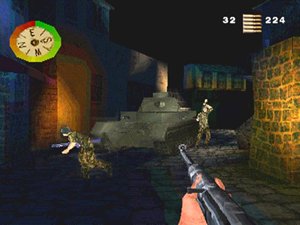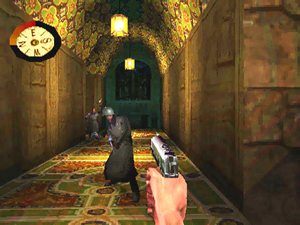Pass the fries, frí¤ulein.
Ah, France, mon ami. All sorts of things originated from France – the stethoscope,
hot air balloons, kissing and french fries. Mmm…french fries. Actually, a vocal
few out there in the french fry community say that these tasty potatoes actually
came from Belgium. Belgians and Frenchmen actually argue and fight over the whole
issue. Seriously.
Well, since there’s no real way to find out, Game Revolution will just have
to take over both Belgium and France, for the waffles, the French/Belgian
fries, the crepes and the women. When it comes to wars, women and fries, Medal
of Honor: Underground succeeds in 2 of the 3. No fries!
Manon Batiste is a seasoned member of the French resistance. In the first
Medal of Honor, she helped out the OSS and
Lieutenant James Patterson. Now, Manon is in the title role as she partakes
in some missions of her own for the Underground movement.
Medal of Honor: Underground actually takes place before the events
in the first game. The OSS and the Underground movement will recruit you on
a variety of missions to help the war effort. These assignments will take you
around France and even to Africa (a la Casablanca) to battle the Nazis.
Kudos to EA for pushing a female heroine in a historical context without relying on big boobs or super-sleuth skills. It would have been easy to fall into a Lara Croft characterization trap or even make Manon into a Joanna Dark super assassin.
Manon works well as a character and helps draw you into the rich, vibrant
world. Few action games on the market can hold a candle to the detailed historical
accuracy of the MOH games. From the plethora of videos and extensive
mission briefings to the terrific credit sequence (videos of real WWII veterans
who are now grandmothers), it’s clear that the developers have done their homework.
The game follows a linear path and sort of guides you towards the goal, with
the mission assignments scattered along the way. There are offshoots here and
there, but I really wanted to see more freedom and a greater sense of a realized
world. Even the larger levels still follow a very linear flow, with too many
locked doors and blocked off entryways. Nonetheless, the levels are still well
designed, particularly when you consider the limited power of the system.
Them damn Nazis are still a force to be reckoned with, but why do they have to feel so scripted? Their AI appears to work within ranges of detection. When you get “noticed” they’ll hightail it for the nearest building corner and peer out to shoot you. If you run away, they’ll follow, looking for the next building corner to hide behind. It gets a bit redundant, but it ain’t too shabby for the PSX.
 Speaking
Speaking
of wall corners, there’s still this strange jerkiness that happens when you
walk into the edges of buildings and most objects. It’s like the screen slightly
displaces. This gets pretty annoying when you are trying to zip through the
narrow hallways.
For that matter, the graphics aren’t much of an improvement from before. Underground
is pushes the abilities of the Playstation, and as far as a first-person shooter
goes, this will be the best you can get on the aging hardware. But what’s the
deal with the daytime missions? Most of the levels in the original game were
at night, which allowed for some fog effects that could hide the pop-up and
graphical glitches. But in the day, that fog won’t cut it. How can you explain
it? Desert sand? Spooky brown fog? Go away, fog!
Each finished level nets you a rating based on your performance. You can use
these scores to compel yourself to play levels over until you earn yourself
an “excellent.” Ah…play it again, Sam. At the end, all your scores are tallied
together. Perhaps you may even be worthy of the Legion d’honneur.
There are several new features in Underground. You’ll have the chance
to work with a CPU controlled buddy, basically a digital comrade that you keep
safe and help out. Not new to the genre, but it still works well. Moving vehicles
have been added, which means you can fight enemies like giant tanks. Then there’s
the disguise element. You’ll nab a camera, after which you can go prancing about
pretending to be a journalist. If you stop to take a photo of German soldier,
he’ll even pose for you. Pull out a gun, though, and he”ll shoot you dead.
Nice!
The game tends to hold your hand through the missions, with text telling you when to use your action button. This is good because it helps things make sense, but it’s also bad because it only pushes that linear feel.
There’s lots of quality voice acting between stages and for mission briefings, but the heavy French accents come off as more Pepe Le Peu than Gerard Depardieu. They’ve kept those great German mutterings from the enemy intact, which ups the realism. Musically, the score is very impressive. Rich and reminiscent of a movie soundtrack, it helps set the atmosphere. And if it isn’t your cup of tea, you can just turn it off.
As a follow-up, Medal of Honor: Underground missed my high expectations,
but only because the first one was such a great start. Underground is
relatively on par with the first Medal of Honor, though the limitations
of the hardware keep the game from such intricacies as civilian bystanders,
deeper, more complex AI, and no more brown fog. I guess that’s what the planned
PS2 version is for, oui?
-
Similar to
-
Rich musical score
-
Detailed historical context
-
Severely limited by the hardware
-
Brown fog?
-
Could use deeper AI











